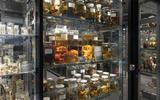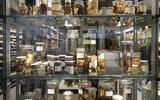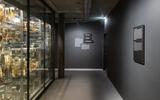2. Life’s secrets revealed in death
This room may look sterile, but it is actually teeming with life: Deep freezers set to minus 80 °C house thousands of tissue samples taken from specimens of scientific collections. Cutting-edge DNA analysis enables scientists to discover new animal species, reliably identify the species an individual belongs to, and shed light on evolutionary relationships. The frozen treasures also contain information about climate change and environmental pollution. This tissue collection is part of the worldwide efforts to understand and protect the diversity of life.
2.1 Bird’s eyes
This collection of bird’s eyes and brains highlights earlier research methods. Before the advent of DNA analyses, scientists used exclusively morphological features to study the evolution and development of living beings. Today research in morphology is an essential complement to genetic analyses.

2.2 What is a puppy doing here?
With 2,800 specimens, the museum houses the largest scientific collection of pedigree dogs in the world. All the dogs died of natural causes and were subsequently donated to the museum. Scientists from all over the world use our dog collection to study, for example, how dogs derived from wolves.

2.3 Bats
Genetic research has uncovered a few surprises in Switzerland’s native bats: In 2019, researchers discovered a new species of mouse-eared bat, Myotis crypticus (‘hidden moused-ear bat’). This species had previously gone unnoticed, as all mouse-eared bats look virtually the same

